|
|
 |
Fiche d'espèce de Copépode |
|
|
Calanoida ( Ordre ) |
|
|
|
Lucicutiidae ( Famille ) |
|
|
|
Lucicutia ( Genre ) |
|
|
| |
Lucicutia longiserrata (Giesbrecht, 1889) (F,M) | |
| | | | | | | Syn.: | Leuckartia longiserrata Giesbrecht, 1892 (p.359, 367, 773, Descr.F, figs.F);
Lucicutia simulans Sars, 1920 c (p.11); 1925 (p.216, figs.F,M); Farran, 1926 (p.278, figs.F,M); Rose, 1933 a (p.195, figs.F,M); Sewell, 1948 (p.503, 509); C.B. Wilson, 1950 (p.257); Grice, 1963 a (p.496); Djordjevic, 1963 (p.576); De Decker & Mombeck, 1964 (p.13); El-Maghraby, 1965 (p.54, Appendix); Mazza, 1966 (p.71); Vinogradov, 1968 (1970) (p.268); Dowidar & El-Maghraby, 1970 (p.268); Kovalev & Shmeleva, 1982 (p.84); Licandro & Icardi, 2009 (p.17, Table 4); Hidalgo & al., 2010 (p.2089, Table 2);
no Lucicutia longiserrata : Sars, 1925 (p.220); Rose, 1933 a (p.195, figs.F,M); ? Jespersen, 1934 (p.105); ? Mazza, 1962 (p.339); Grice, 1963 a (p.496); Grice & Hülsemann, 1965 (p.224); ? Mazza, 1966 (p.71) | | | | Ref.: | | | Giesbrecht & Schmeil, 1898 (p.112, Rem. F); Farran, 1908 b (p.64, figs.F, Rem.); A. Scott, 1909 (p.127, Rem.); Wolfenden, 1911 (p.323); Jespersen, 1934 (p.105); Tanaka, 1963 (p.32, figs.F,M); Hülsemann, 1966 (p.723, figs.F,M, Rem.); Heptner, 1971 (p.126, 127); Chihara & Murano, 1997 (p.830: tab.5); Lapernat, 1999 (p.22, 55, fig.F); Bradford-Grieve,1999 b (p.101, figs.F,M, Rem., figs.177, 191); Boxshall & Halsey, 2004 (p.133: F; p.135: M); Vives & Shmeleva, 2007 (p.338, figs.F,M, Rem.) | 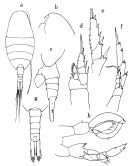 issued from : O. Tanaka in Publs Seto Mar. Biol. Lab., 1963, XI (1). [p.33, Fig.163]. Female: a, habitus (dorsal); b, forehead (left lateral side); c, last thoracic segment and urosome (left lateral side); d, P1; e, exopod of P2; f, P5. Nota: The urosome segments and furca in the proportioal lengths as 31:10:10:17:32 = 100. The furcal rami 4-times as long as is wide at the proximal. Male: g, urosome (dorsal); h, P5. Nota: The urosome segments and furca in the proportioal lengths as 13:13:13:9:14:38 = 100.
|
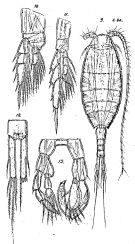 Issued from : G.O. Sars in Résult. Camp. Scient. Prince Albert I, 69, pls.1-127 (1924). [Pl.LVIII, figs.9-13]. As Lucicutia simulans. Female: 9, habitus (dorsal); 10, P1; 11, P5; 12, anal segment and caudal rami (dorsal). Male: 13, P5.
|
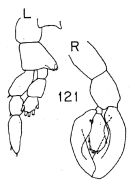 Issued from : K. Hülsemann in Bull. Mar. Sc., 1966, 16 (4). [p.728, Fig.121]. Male: 121, P5. L= left leg; R = right leg.
|
 Issued from : K. Hülsemann in Bull. Mar. Sc., 1966, 16 (4). [p.722, Fig.86]. Female: 86, P5.
|
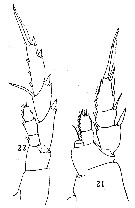 issued from : G.P. Farran in Fish. Ire. Sci. Invest., 1906, II [1908]. [Pl. VI, Figs.21-22]. Female (from 53°7'N, 15°6'W): 21, P1; 22, P5. Nota: The tubular basal process of P1 is not so long as shown in Giesbrecht's figure.
|
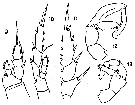 issued from : G.P. Farran in Biscayan Plankton collected during a Cruise of H.M.S. 'Research', 1900.- Part XIV. The Copepoda. (Linn. Journ. Zoology, XXXVI, 1926). [p.304, Pl.9, Figs.9-13]. As Lucicutia simulans. Female: 9, P1; 10, P5; 11, P2. Male: 12, right P5; 13, left P5.
|
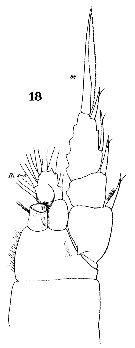 Issued from : W. Giesbrecht in Systematik und Faunistik der Pelagischen Copepoden des Golfes von Neapel und der angrenzenden Meeres-Abschnitte. - Fauna Flora Golf. Neapel, 1892. Atlas von 54 Tafeln. [Taf. 19, Fig.18]. As Leuckartia longiserrata. Female: 18, P1 (anterior view). St = terminal spine; Ri 2-3 = endopodal segment 2-3.
|
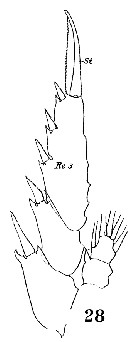 Issued from : W. Giesbrecht in Systematik und Faunistik der Pelagischen Copepoden des Golfes von Neapel und der angrenzenden Meeres-Abschnitte. - Fauna Flora Golf. Neapel, 1892. Atlas von 54 Tafeln. [Taf. 19, Fig.28]. As Leuckartia longiserrata. Female: 28, exopod and endopod of P2.
|
 Issued from : W. Giesbrecht in Systematik und Faunistik der Pelagischen Copepoden des Golfes von Neapel und der angrenzenden Meeres-Abschnitte. - Fauna Flora Golf. Neapel, 1892. Atlas von 54 Tafeln. [Taf. 19, Fig.25]. As Leuckartia longiserrata. Female: 25, P5. Si = inner spine; Se = outer spine; Re 3 = exopodal segment 3.
|
 Issued from : W. Giesbrecht in Systematik und Faunistik der Pelagischen Copepoden des Golfes von Neapel und der angrenzenden Meeres-Abschnitte. - Fauna Flora Golf. Neapel, 1892. Atlas von 54 Tafeln. [Taf. 19, Fig.1]. As Leuckartia longiserrata. Female: 1, 4th segment of A1 (ventral view). Aes = aesthetasc; Sdi = distal spine; Spr = proximal spine.
|
 Issued from : W. Giesbrecht in Systematik und Faunistik der Pelagischen Copepoden des Golfes von Neapel und der angrenzenden Meeres-Abschnitte. – Fauna Flora Golf. Neapel, 1892, 19 , Atlas von 54 Tafeln. [Taf.38, Fig. 36]. As Leuckartia longiserrata. Female: 36, urosome (ventral).
|
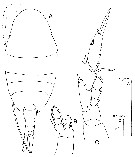 issued from : J.M. Bradford-Grieve in The Marine Fauna of New Zealand: Pelagic Calanoid Copepoda. National Institute of Water and Atmospheric Research (NIWA). NIWA Biodiversity Memoir, 111, 1999. [p.103, Fig.67, A-C]. Female (28°52'S, 178°054E)): A, habitus (dorsal); B, P1; C, P5.
|
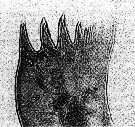 issued from : P.E. Lapernat & C. Razouls in Vie Milieu, 2002, 52 (1). [p.21, Pl. II, fig.3]. Masticatory edge of Md gnathobase female (from off Malta, Mediterranean Sea).
|
 Lucicutia longiserrata Lucicutia longiserrata female: 1 - Characters following not combined : Prosome about 3 times longer than urosome. Cephalosome with slightly projecting and rounded anterior corners and well developed lateral spinous projections; anal somite about as long as wide; caudal rami 11.7 times longer than wide and bowed outwards at base, leaving elliptical space between rami proximally. 2 - P1 with 2-segmented endopod. 3 - Cephalosome not with 2 pairs of lateral spinous projections, but with other forms. 4 - A1 extending to end of caudal ramus or 1 to 2 segments beyond. 5 - Caudal rami 3 to 4 times longer than wide. 6 - Terminal setal element of P5 a little shorter than 3rd exopodal segment.
|
 Lucicutia longiserrata Lucicutia longiserrata male: 1 - P1 with 2-segmented endopod; 2 - Caudal rami less than 10 times longer than wide. 3 - Inner distal corner of basis of P5 without strong spine. 4 - Basis of left P5 ornamented differently from L. oblonga. 5 - Caudal rami about 3 to 5 times longer than wide. 6 - A1 reaching beyond tip of caudal rami by 2 segments; inner distal corner of basis of left P5 produced, ornamented with 2 or 3 teeth, 1 small seta and a rounded process.
| | | | | Ref. compl.: | | | Massuti Alzamora, 1942 (p.111); C.B. Wilson, 1950 (p.256); Grice, 1963 a (p.496); Furuhashi, 1966 a (p.295, vertical distribution in Kuroshio region, Table 9); Mazza, 1967 (p.367); Grice & Hulsemann, 1967 (p.17); Vinogradov, 1968 (1970) (p.268); Park, 1970 (p.477); Roe, 1972 (p.277, tabl.1, tabl.2); Björnberg, 1973 (p.343, 387); Deevey & Brooks, 1977 (p.256, tab.2, Station "S"); Vaissière & Séguin, 1980 (p.23, tab.2); Kovalev & Shmeleva, 1982 (p.84); Vives, 1982 (p.293); Scotto di Carlo & Ianora, 1983 (p.150); Scotto di Carlo & al., 1984 (1041); Roe, 1984 (p.358); Lozano Soldevilla & al., 1988 (p.59); Pancucci-Papadopoulou & al., 1990 (p.199); Scotto di Carlo & al., 1991 (p.270); Shih & Young, 1995 (p.70); Lapernat, 2000 (tabl.3, 4); Lapernat & Razouls, 2001 (p.123, tab.1); Holmes, 2001 (p.17); Weikert & al., 2001 (p.229, fig.7, Rem.); Koppelmann & Weikert, 2007 (p.266: tab.3); Gaard & al., 2008 (p.59, Table 1, N Mid-Atlantic Ridge); Licandro & Icardi, 2009 (p.17, Table 4); Mazzocchi & Di Capua, 2010 (p.426); Medellin-Mora & Navas S., 2010 (p.265, Tab. 2); Brugnano & al., 2012 (p.207, Table 2, 3); El Arraj & al., 2017 (p.272, table 2); Belmonte, 2018 (p.273, Table I: Italian zones) | | | | NZ: | 13 + 1 douteuse | | |
|
Carte de distribution de Lucicutia longiserrata par zones géographiques
|
| | | | | | | | | | | | | Loc: | | | South Africa (E), Cape Verde Is., off NW Cape Verde Is., off Mauritania, off Moroccan Atlantic Coast, off Madeira, Azores, off W Cape Finisterre, Bay of Biscay, off Portugal, E Caribbean, Caribbean Sea, Caribbean Colombia, G. of Mexico, off Bermuda (Station "S"), Sargasso Sea, ? Strait of Davis S, off W Ireland, Ibero-moroccan Bay, Medit. (NW Basin, G. of Lion, off Monaco, Ligurian Sea, Tyrrhenian Sea, Strait of Messina, off Malta, Adriatic Sea, Ionian Sea, Lebanon Basib, Egypt coast, Alexandria), Indian, Indonesia-Malaysia, Philippines, China Seas (South China Sea), off Taiwan, Japan, Marshall Is., Pacif. ( E & SE ), Chile (N-S), off New Zealand (NE, NW) | | | | N: | 42 | | | | Lg.: | | | (1) F: 2,4; (21) F: 3-2; M: 2,5-1,9; (24) F: 3; (26) F: 2,52; M: 1,88; (38) F: 2,82-2,64; M: 2,52; (47) F: 2,2; (199) F: 2,58-2,05; M: 2,28-1,82; (340) F: 2,6-2,25; (909) F: 2,2-2,6; M: 1,9; {F: 2,00-3,00; M: 1,82-2,52} | | | | Rem.: | Bathypélagique (épipélagique in A. Scott, 1909; méso-bathypélagique in Roe, 1972; 1984).
Du fait des synonymies, la répartition géographique correcte de cette espèce est difficile à établir.
Voir aussi les remarques en anglais | | | Dernière mise à jour : 24/10/2022 | |
|
|
 Toute utilisation de ce site pour une publication sera mentionnée avec la référence suivante : Toute utilisation de ce site pour une publication sera mentionnée avec la référence suivante :
Razouls C., Desreumaux N., Kouwenberg J. et de Bovée F., 2005-2025. - Biodiversité des Copépodes planctoniques marins (morphologie, répartition géographique et données biologiques). Sorbonne Université, CNRS. Disponible sur http://copepodes.obs-banyuls.fr [Accédé le 17 décembre 2025] © copyright 2005-2025 Sorbonne Université, CNRS
|
|
 |
 |















